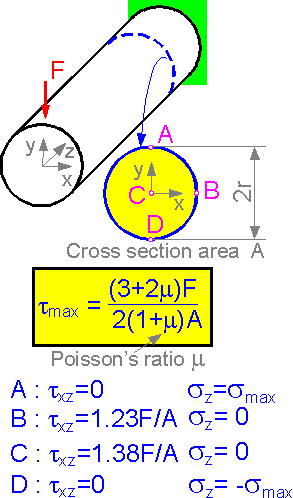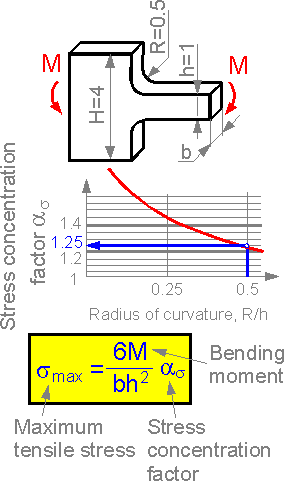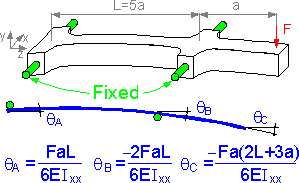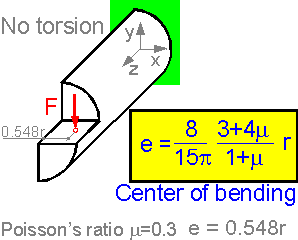 There are shear and tensile stresses in bending beams. Usually the beams fail due to bending tensile stress. An exception is beams with high h/L ratio. A height increase results in an increase in the tmax/smax ratio.
There are shear and tensile stresses in bending beams. Usually the beams fail due to bending tensile stress. An exception is beams with high h/L ratio. A height increase results in an increase in the tmax/smax ratio.
The shear stress is at a maximum and there is no tensile bending stress at the neutral line of a bending beam. The maximum tensile stress act at the upper or lower segments of the beam.
The principle planes are planes where there are no shear stresses and the normal stresses are at a maximum. The principle axes are inclined by 45o to the neutral axis. The principle axes coincide with the coordinate axes at the upper and lower sections of a bending beam.
 The neutral line is shifted to the center for a curved beam. The absolute value of the maximum compressive stress is smaller than that for tension for the shown loading condition. For R/h > 20 the stress field can be considered the same as for a straight beam.
The neutral line is shifted to the center for a curved beam. The absolute value of the maximum compressive stress is smaller than that for tension for the shown loading condition. For R/h > 20 the stress field can be considered the same as for a straight beam.
 The maximum shear stress depends on the transverse force F, the cross-sectional area A and Poisson's ratio m. The shear stress is at a maximum in the center of the section. The bigger the distance from the neutral axis, the bigger the bending tensile stress.
The maximum shear stress depends on the transverse force F, the cross-sectional area A and Poisson's ratio m. The shear stress is at a maximum in the center of the section. The bigger the distance from the neutral axis, the bigger the bending tensile stress.
 There is a stress concentration in the bending beam. The stress concentration factor depends on the ratio of the radius of curvature to the decreased height of the beam.
There is a stress concentration in the bending beam. The stress concentration factor depends on the ratio of the radius of curvature to the decreased height of the beam.
 The figure shows a curved central line of the beam. The angle of rotation is at a maximum at the right edge of the beam.
The figure shows a curved central line of the beam. The angle of rotation is at a maximum at the right edge of the beam.
 Shear stress can result in torsion of non-symmetrical sections. Applying force at a distance e=0.548r does not cause torsion of the beam with a half-round cross section.
Shear stress can result in torsion of non-symmetrical sections. Applying force at a distance e=0.548r does not cause torsion of the beam with a half-round cross section.
 2015-08-13
2015-08-13 389
389








